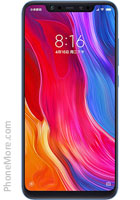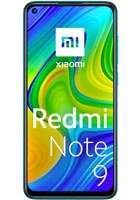Xiaomi Mi 8 (256GB) vs Xiaomi Redmi Note 9 (128GB/4GB)
Side by side comparison between Xiaomi Mi 8 vs Xiaomi Redmi Note 9 phones, differences, pros, cons and full specifications. What's the better?
,
6.21"
AMOLED
AMOLED
1080x2248
12
MP
MP
20mp
6GB
RAM
RAM
Octa-core
3400
mAh
mAh
(Non removable)
vs
6.53"
IPS
IPS
1080x2340
48
MP
MP
13mp
4GB
RAM
RAM
Octa-core
5020
mAh
mAh
(Non removable)
What's the better phone? Xiaomi Mi 8 (256GB)
The phonemore's choice is much more technical than personal. Therefore, you shouldn't only consider this. Our goal is to help you, but what's important to us may not be important to you. You decide which one is the best! Comment!
| 29 Common items in both devices |
| 60Hz |
| 16 million |
| PDAF: phase detection autofocus |
| HDR photo on both cameras |
| f/1.8 (aperture) |
| (front) Full HD (1920x1080) |
| 4G LTE-A |
| +22 specs and more in the table below |
Check the comparison table below for more items that are not evaluated in comparison score above.
Highlight differences Clear highlight📱 Model features | ||
| Xiaomi Mi 8 (256GB) | Redmi Note 9 (128GB/4GB) | |
| Model | Xiaomi Mi 8 (256GB) | Redmi Note 9 (128GB/4GB) |
| Other model names | 小米8, Xiaomi Mi8 6GB RAM, Xiaomi Dipper | Mi Redmi Note 9 CX296VRD, CX296CIN, M2003J15SS/2003J15SC |
| Country or region available |    (Global, International), China, Hong Kong |    Brazil, China, India |
| Brand | Xiaomi | Xiaomi |
| Release date | 6/1/2018 | 5/12/2020, Announced: 4/30/2020 |
| Depth | 7.6 millimeters (0.3 inches) | 8.9 millimeters (0.35 inches) |
| Size (width x height) | 74.8 x 154.9 millimeters (2.94 x 6.1 in) | 77.2 x 162.3 millimeters (3.04 x 6.39 in) |
| Weight | 175 grams (6.13 ounces) | 199 grams (6.97 ounces) |
| Build, materials | Aluminum frame, glass front/back | Plastic body, glass front |
| Protection against water and others | Not supported | Water repellent nano-coating (don't immerse) |
📲 Display | ||
| Xiaomi Mi 8 (256GB) | Redmi Note 9 (128GB/4GB) | |
| Display type | Super AMOLED | TFT IPS LCD |
| Screen size | 6.21" inches | 6.53" inches |
| Screen-to-body ratio | ~83.8% (screen-to-body ratio) | ~83.5% (screen-to-body ratio) |
| Display resolution | 1080x2248 pixels | 1080x2340 pixels (19.5:9) |
| Touchscreen | Capacitive Multitouch | Capacitive Multitouch |
| Pixel density (dot pitch) | 402 PPI | 395 PPI |
| Colors | 16 million | 16 million |
| Scratch-resistant glass | Gorilla Glass 5 | Gorilla Glass 5 |
| Refresh rate | 60Hz | 60Hz |
| Display features | 600nits[typ] HDR10 | 450nits[typ] |
🤖 Operating System | ||
| Xiaomi Mi 8 (256GB) | Redmi Note 9 (128GB/4GB) | |
| System version | Android 8.1 Oreo | Android 10 |
| Firmware update | Android 9.0 Pie | Android 11 |
| User Interface | feature not registered | MIUI 11 / 12 |
⚙️ Processor | ||
| Xiaomi Mi 8 (256GB) | Redmi Note 9 (128GB/4GB) | |
| Chipset | 64bit: Qualcomm Snapdragon 845 MSM8998 (10nm) | 64bit: MediaTek Helio G85 (12nm) |
| CPU | Octa-core, 2 processors: 4x 2.8GHz Kryo 385 Gold (Quad-core) 4x 1.8GHz Kryo 385 Silver (Quad-core) | Octa-core, 2 processors: 2x 2GHz ARM-Cortex-A75 (Dual-core) 6x 1.8GHz ARM-Cortex-A55 (Hexa-core) |
| GPU graphical controller | Qualcomm Adreno 630 710Mhz | ARM Mali-G52 MC2 (1GHz) |
| Performance (benchmark) | feature not registered | AnTuTu: 200451 (v8) Geekbench: 1292 (v5.1) |
💽 Memory and storage | ||
| Xiaomi Mi 8 (256GB) | Redmi Note 9 (128GB/4GB) | |
| RAM memory | 6GB LPDDR4X | 4GB LPDDR4X |
| Internal storage | 256GB (243GB available) UFS 2.1 | 128GB (106GB available) eMMC 5.1 |
| External storage | Not supported | Until 512GB microSD, microSDXC (dedicated slot) |
📶 Mobile networks | ||
| Xiaomi Mi 8 (256GB) | Redmi Note 9 (128GB/4GB) | |
| Dual-SIM | Dual-SIM Standby - Call active on one sim card | Dual-SIM Standby - Call active on one sim card (dedicated slot) |
| SIM card | 2 slots (Dual-SIM) nano-SIM (4FF) | 2 slots (Dual-SIM) nano-SIM (4FF) |
| Maximum Download / Upload | 1024/150 Mbps | 300/150 Mbps |
| Network technology | 2G, 3G, 4G | 2G, 3G, 4G |
| Frequency, bands | Expand band details Collapse details | |
| GSM MHz band | Quad-Band 850/900/1800/1900 | Quad-Band 850/900/1800/1900 |
| Primary 2G network | CDMA 800, GSM 850/900/1800/1900 | GSM 850/900/1800/1900 |
| Primary 3G network | CDMA2000 1xEV-DO TD-SCDMA 1900/2000 UMTS 850/900/1700/1900/2100 | UMTS 850/900/1700/1900/2100 |
| Primary 4G network | LTE Cat16 (1, 2, 3, 4, 5, 7, 8, 12, 17, 20) TD-LTE (34, 38, 39, 40, 41) VoLTE | LTE Cat7 (1, 2, 3, 4, 5, 7, 8, 20, 28) TD-LTE (38, 40, 41) VoLTE |
| Primary 5G network | Not supported | Not supported |
| Primary data network | GPRS, EDGE, CDMA2000 EV-DO Rev 0, CDMA2000 EV-DO Rev A, TD-SCDMA, UMTS, TD-HSDPA, HSDPA, HSUPA, HSPA+, TD-LTE, LTE, LTE-A | GPRS, EDGE, UMTS, HSDPA, HSUPA, HSPA+, TD-LTE, LTE, LTE-A |
| Secondary 2G network | GSM 850/900/1800/1900 | GSM 850/900/1800/1900 |
| Secondary 3G network | Not supported | UMTS 850/900/1700/1900/2100 |
| Secondary 4G network | Not supported | LTE Cat7 (1, 2, 3, 4, 5, 7, 8, 20, 28) TD-LTE (38, 40, 41) VoLTE |
| Secondary data network | GPRS, EDGE | GPRS, EDGE, UMTS, HSDPA, HSUPA, HSPA+, TD-LTE, LTE, LTE-A |
📷 Camera | ||
| Xiaomi Mi 8 (256GB) | Redmi Note 9 (128GB/4GB) | |
| Back camera (main camera) | (dual camera) 12 megapixels 12MP telephoto f/2.456mm1/3.4"1.0µmAF2x-optical-zoom | (quad camera) 48 megapixels 8MP ultrawide f/2.213mm1/4"1.12µm118° 2MP macro f/2.41.75µmAF 2MP depth f/2.41/5"1.7µm |
| Main camera resolution | 4000x3000 pixels | 8000x6000 pixels |
| Video recording (primary) | 4K UHD (3840x2160) 30 fps | Full HD (1920x1080) 30 fps |
| Flash | Dual-LED flash | LED flash |
| Focal aperture | f/1.8 (aperture) | f/1.8 (aperture) |
| Focal length | feature not registered | 26mm (lens) |
| Sensor size | 1/2.55" inches | 1/2" inches |
| Pixel size | 1.4µm pixel | 0.8µm pixel |
| Autofocus | PDAF: phase detection autofocus | PDAF: phase detection autofocus |
| Touch focus | Supported | Supported |
| Image stabilization | OIS (4-axis): Optical stabilization | EIS: Digital stabilization |
| Zoom | Digital and optical zoom | Only digital zoom |
| Face/smile detection | Face detection, Smile detection | Face detection, Smile detection |
| BSI sensor | Not supported | Supported |
| HDR | HDR photo on both cameras | HDR photo on both cameras |
| Camera extras | feature not registered | feature not registered |
📸 Front camera | ||
| Xiaomi Mi 8 (256GB) | Redmi Note 9 (128GB/4GB) | |
| Front camera (secondary) | 20 megapixels | 13 megapixels |
| Front camera resolution | 5184x3840 pixels | 4128x3096 pixels |
| Video recording (secondary) | Full HD (1920x1080) | Full HD (1920x1080) |
| Front flash | Not supported | Not supported |
| Focal aperture | f/2.0 (aperture) | f/2.3 (aperture) |
| Focal length | feature not registered | 29mm (lens) |
| Sensor size | 1/3" inches | 1/3.06" inches |
| Pixel size | 1.8µm pixel | 1.12µm pixel |
🔉 Sound and multimedia | ||
| Xiaomi Mi 8 (256GB) | Redmi Note 9 (128GB/4GB) | |
| Loudspeaker | Supported | Mono sound (not stereo) |
| Active noise cancellation | 2 microphones or more | 2 microphones or more |
| Radio | Not supported | FM |
| TV | Not supported | Not supported |
| Video formats | MP4, H.265, H.264, H.263, XviD, MKV | MP4, H.265, H.264, H.263, XviD, MKV |
| Audio formats | MP3, WAV, WMA, eAAC+, FLAC | MP3, WAV, WMA, eAAC+, FLAC |
🔌 Connectivity | ||
| Xiaomi Mi 8 (256GB) | Redmi Note 9 (128GB/4GB) | |
| USB | USB 2.0 Type-C, USB OTG On-The-Go | USB 2.0 Type-C, USB OTG On-The-Go |
| Audio output | Type-C jack with 3.5mm jack adapter | 3.5mm jack |
| TV output | USB Type-C (reversible) | USB Type-C (reversible) |
| Bluetooth | 5.0 + A2DP/LE | 5.0 + A2DP/LE |
| WiFi | 802.11 a/b/g/n/ac [wifi5] (2.4GHz, 5GHz) + MIMO WiFi Direct, hotspot | 802.11 a/b/g/n/ac [wifi5] (2.4GHz, 5GHz) + MIMO WiFi Direct, hotspot |
| DLNA | Supported | Not supported |
| GPS | A-GPS, GeoTagging, GLONASS, GALILEO, BeiDou, QZSS | A-GPS, GeoTagging, GLONASS, GALILEO, BeiDou |
| NFC | Supported | Not supported |
| Infrared port | Not supported | Supported |
🧭 Sensors | ||
| Xiaomi Mi 8 (256GB) | Redmi Note 9 (128GB/4GB) | |
| Sensors | Accelerometer Ambient light sensor Barometer Compass Face unlock 2D Fingerprint sensor (rear-mounted) Gyroscope Hall effect Proximity sensor | Accelerometer Ambient light sensor Compass Face unlock 2D Fingerprint sensor (rear-mounted) Gyroscope Proximity sensor |
| Vibrating alert | Supported | Supported |
🔋 Battery | ||
| Xiaomi Mi 8 (256GB) | Redmi Note 9 (128GB/4GB) | |
| Battery type | LiPo: li-ion polymer (Non removable) | LiPo: li-ion polymer (Non removable) |
| Battery capacity | 3400 mAh | 5020 mAh |
| Charger, watts | 18W Wired fast charging Quick Charge 4+ | 18W Wired fast charging 9W Reverse charging by cable |
| Inductive / wireless charging | Not supported | Not supported |
| Talk time autonomy | feature not registered | 33 hours (1.4 days) |
| Standby | feature not registered | feature not registered |
➕ Other features | ||
| Xiaomi Mi 8 (256GB) | Redmi Note 9 (128GB/4GB) | |
| Call control | Voice dialing, Voice recorder, Voice commands | Voice dialing, Voice recorder, Voice commands |
| Messaging | SMS (T9), MMS, E-mail, Push mail | SMS (T9), MMS, E-mail, Push mail |
| Hands-free calling | Supported | Supported |
| Video calling | Supported | Supported |
| Ringtones | Polyphonic and customized | Polyphonic and customized |
| Web browser | HTML, XHTML, HTML5 | HTML, XHTML, HTML5 |
| Antenna | Internal antenna | Internal antenna |
| Qwerty physical keyboard | Not supported | Not supported |
| Miscellaneous | • Colors: Black, Blue, White, Gold • MIUI 9.5 • Always-On Display • WiFi display | • Colors: Forest Green, Midnight Grey, Polar White • 22.5W charger (18W phone support) |
☢️ Radiation rate | ||
| Xiaomi Mi 8 (256GB) | Redmi Note 9 (128GB/4GB) | |
| SAR 1.6W/kg (USA, Mexico, etc.) | feature not registered | 0.84W/kg (head), 0.9W/kg (body) |
| SAR 2W/kg (Europe, UK, etc.) | feature not registered | 0.8W/kg (head), 1.14W/kg (body) |


 19 Advantages
19 Advantages  11 Advantages
11 Advantages